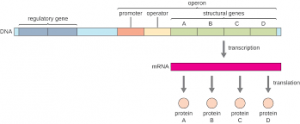Zoology Notes On – Operon Theory – For W.B.C.S. Examination.
Operon Theory is the concept of gene regulation proposed by François Jacob and Jacques Monod (1961). An operon is a group of structural genes whose expression is coordinated by an operator. The repressor encoded by a regulatory gene binds to the operator and represses the transcription of operon.Continue Reading Zoology Notes On – Operon Theory – For W.B.C.S. Examination.
In the presence of inducer, the repressor is inactivated and dissociates from operator to express the operon. Thus, the expression of the operon is controlled by a cis-acting operator and by a trans-acting repressor.
In prokaryotes, many functionally related structural genes involving catabolite metabolism or biosynthetic pathways are arranged adjacently on the genome to form an operon. The genes are transcribed as a single mRNA from a promoterwhich is located at the 5′ end of the first gene.
Operons are regions of DNA that contain clusters of related genes. They are made up of a promoter region, an operator, and multiple related genes. The operator can be located either within the promoter or between the promoter and the genes. RNA polymerase initiates transcription by binding to the promoter region. The location of the operator is important as its regulation either allows or prevents transcription of the genes into mRNA.
Operon Function
An operon is a complete package for gene expression and synthesis of polypeptides. By combining the related genes, all polypeptides required for a specific function are synthesized in response to a single stimulus. For example, the bacterium Escherichia coli contains a number of genes clustered into operons and regulons: the Lac operon which is involved in lactose degradation, the Trp operon which is involved in tryptophan biosynthesis, and the His operon which is involved in histidine biosynthesis. These operons are turned on when the gene products are needed.
Operons can be under negative or positive control. Negative control involves turning off the operon in the presence of a repressor; this can be either repressible or inducible. A repressible operon is one that is usually on but which can be repressed in the presence of a repressor molecule. The repressor binds to the operator in such a way that the movement or binding of RNA polymerase is blocked and transcription cannot proceed. An inducible operon is one that is usually off. In the absence of an inducer the operator is blocked by a repressor molecule. When the inducer is present it interacts with the repressor protein, releasing it from the operator and allowing transcription to proceed. Repressible operons are generally involved in anabolic pathways, or the synthesis of an essential component, while inducible operons are generally involved in catabolic pathways, or the breakdown of a nutrient. Positive control of an operon is when gene expression is stimulated by the presence of a regulatory protein.
Lac Operon
The Lac operon is the classic operon example, and is responsible for the degradation of the milk protein lactose. The Lac operon is an inducible operon; in the absence of lactose the operator is blocked by a repressor protein. The operon is made up of a promoter with operator, and three genes (lacZ, lacY, and lacA) which encode β-galactosidase, permease, and transacetylase. The three genes are involved in the breakdown of lactose into its metabolites: β-galactosidase breaks lactose down into glucose and galactose, while the other two proteins aid in the metabolic process. The expression of the Lac operon is controlled by the regulatory gene lacI, located immediately adjacent to the promoter region. LacI encodes an allosteric repressor protein that keep the Lac operon “off”.
In order for the Lac operon to be turned on, an inducer molecule must inactivate the repressor protein. The inducer molecule in this system is allolactose, an isomer of lactose. When lactose and its isomer are present in the cell, allolactose will bind to allosteric sites on the repressor protein, changing its conformation and rendering it inactive. As the repressor protein detaches from the operator, RNA polymerase can bind to the promoter, transcription can occur, and the three lactose degradation genes can be synthesized.
Please subscribe here to get all future updates on this post/page/category/website


 +919674493673
+919674493673  mailus@wbcsmadeeasy.in
mailus@wbcsmadeeasy.in







































































































